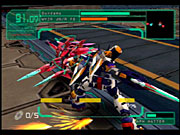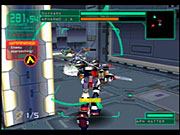Virtual On Marz is the first new entry in Sega's manic robot action series in the US since Oratorio Tangram landed on the Dreamcast. Though more than three years have passed since then, the Virtual On formula remains the same in the most significant ways. The breakneck arcade style of play that Virtual On is built on has been improved upon by other games since Oratorio Tangram, and Marz ends up feeling dated, like a Dreamcast game time forgot.

Though the main story mode in Virtual On Marz is lamely pushed forward by a narrative that loosely pertains to the events in previous Virtual On games, what really runs the Virtual On universe are very big robots who fight with other very big robots in arena-style settings. The action boils down to entering an arena, destroying your opponents before they destroy you, and then moving on to a new fight. Actually, the game doesn't need to do any boiling, because that's really all there is to it. Your tactics may have to be modified, depending on the strengths and weaknesses of the robots you're facing, but hopefully you enjoy straightforward one-on-one robot fighting, because that's what Marz has to offer.
It would be fine, really, if the combat held some incredible depth and there were some detailed mech customization options, but Virtual On Marz has neither. Though the game touts more than 40 different playable robots, each with its own special skills, they all fundamentally do the same things. You've got some basic ranged energy attacks, some up-close melee attacks, a few different high-powered special attacks, a rocket-powered jump, and a multidirectional dash move that can be performed on the ground or while in the air. Attacks are largely automated, with a single button unleashing either ranged or melee assaults depending on your range from the enemy you've currently locked on to. This is good, because managing the movement of your robot requires your full attention. The robots move backward, forward, left, right, up, and down with grace, but they are needlessly difficult to rotate. Manually rotating your mech is a frustratingly slow process that will just get you killed. The best way to keep tabs on your target is to jump into the air, automatically turning the focus of your robot onto whatever you're currently locked on to. This seems more like a weird workaround for someone who is using a broken controller rather than an actual, workable control scheme. There's not much for tactics, either, and well-timed dashing and shooting tend to be the keys to consistent victory. There are four different control schemes available, two of which ostensibly re-create an arcade twin stick setup, but none of them are able to surmount the inherently simplistic gameplay. The controls, which were part of what drew fans to the Virtual On games in the first place, are now simply outmoded and needlessly arcane, even sucking most of the potential fun out of the challenge and multiplayer modes, which basically just strip out the dry, truncated storytelling from the "dramatic" story mode and cut straight to the action.

While there are several different aesthetic routes you can take with the giant robot genre these days, Virtual On Marz sticks closely to the anime-inspired archetype. It takes equal parts Macross and Gundam and creates outlandish robots with an excessive number of fins, wings, and ornate headdresses. These robots are then put into abstract metallic, cyber-inspired environments. Though you'll fight in arenas on Mars, Jupiter, the moon, and other galactic locations, none of them have any real unique atmosphere. At best you'll feel like you're fighting in a moon-themed arena, while at worst you'll feel like you're just fighting in a big metal box. In its time, the original Virtual On game was a visual treat, pushing polygons and dishing out special lighting and particle effects in big, impressive dollops. Technology has advanced since then, but Virtual On hasn't really kept up, so what passed for jaw-dropping 3D graphics in the 20th century are no longer as impressive. The game is definitely playing to its arcade roots, as there's a crispness to the presentation and a certain intensity in the color saturation that legitimately make it look like a pumped-up Model 3 game. Hitmaker, a developer most at home when catering to the arcade crowd, creates a look and feel seemingly designed to inspire you to put some tokens into some kind of slot. Even the music sounds like "attract mode tunes" designed to lure you in with their upbeat, mercilessly looping melodies. All of this could be appealing for Sega devotees who don't want to let go of their Dreamcasts, but to modern gamers the robot designs will feel trite, and the whole Virtual On Marz package will just feel tired.
Diehard Virtual On fans will inevitably find some things worth praising in Marz, but the fact remains that Marz simply feels antiquated. While Virtual On has stuck close to its formula, other games have since distilled the giant robot experience into different formats that give people more of what they like about massive humanoid-shaped robots. Capcom's Steel Battalion games take the tank-control concept to a baroque new extreme, and Konami's Zone of the Enders series delivers weightless, anime-style action in mind-rending quantities. Most people outside of Virtual On's established fan base will have a hard time finding a very satisfying experience in this game.